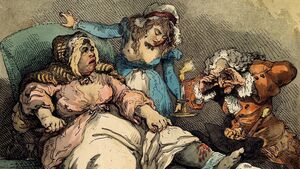A history of prostitution in Athy

‘A Bawd on Her Last Legs’, by Thomas Rowlandson, 1792
DESPITE the fact that over 1,200 inmates of the local Workhouse died during the Great Famine I have been unable to find any references to these deaths in the minute books of the Athy town commissioners.
Indeed, references to the Great Famine were not found anywhere in the town commissioners’ minute books. The recently elected town commissioners had busied themselves in attempts to remove the turnpike gate on the Castlecomer Road.
At a meeting in Kennedy’s Hotel on 27 April 1846 the Town Commissioners and the local farmers agreed to the removal of the turnpike gate, resulting in the free passage of goods in and out of Athy.
Seven years later Alexander Duncan in a speech at the inauguration dinner for the commissioners new chairman, Michael Lawler, referred to the progress Athy had made in the previous 20 years. However, one area in which complaints were still raised by some members of the local society related to the presence on the streets of Athy of the world’s oldest profession.
As a garrison town with a cavalry barracks at Woodstock it was inevitable that the issue would be a source of concern for the town fathers.
The first mention of prostitution in the minute books of the Athy commissioners was recorded on 11 August 1856 when the commissioners appointed Mr Cross and H. Hannon to wait on the local magistrates relative to the scandal of public prostituting in the town.
On 2 August 1858 the commissioners had a public notice posted throughout the town.
‘Caution to persons keeping any place of public resort within the town for the sale of refreshments of any kind who knowingly supplies any common prostitute or resorting therein to assemble and continue in his premises after this notice will be prosecuted according to law. By order Henry Sheill town clerk.’
On 2 May 1859 Thomas Roberts was appointed assistant to the ‘Inspector of Nuisances’ for the purpose of prosecuting public prostitutes and street beggars for which he was to be paid four shillings per week with an additional two shillings and six pence for each conviction of a prostitute.
Roberts brought a number of local prostitutes before the magistrates the following June, but all the cases were dismissed as the magistrate considered the method of paying Roberts two shillings and six pence for each conviction ‘injudicious.’
Thereafter Mr Roberts efforts were largely confined to dealing with the vagrant beggars which the town commissioners on 1 September 1860 noted were to be found standing at doors or loitering about obstructing the public.
The town commissioners’ attempt to rid the town of prostitutes was by all accounts less provocative, and certainly more law abiding than the measures adopted by Fr Thomas Lawler, the local parish priest.
On 1 August 1829, Fr Lawler had three ‘bad women’ stripped and chained. Their offences were not stated, nor was the extent of the stripping or nature of their chaining detailed.
However, it is reasonably safe to assume that the three ‘bad women’ were members of the profession which always proliferated in towns such as Athy where army barracks were located.
Fr Lawler, who had been ordained to the priesthood in 1816, was appointed PP of St Michael’s Athy in 1825, a position he held until his death on 15th June 1835. He was only 44 years of age when he died.
On 8 January 1862 the commissioners posted the following notice throughout Athy.
‘Whereas it had been brought under the notice of the Commissioners a nuisance existing within the township viz vagrants constantly begging on the public street and at private doors. I hereby direct that in all cases where the law is violated same vagrants be summoned before the Justice. Robert Molloy Chariman.’
Apparently the vagrants, beggars and prostitutes took little heed of such stern exhortations as we find the town commissioners on 6 July 1868 resolving ‘to appoint a man to take care that all vagrants and beggars be kept out of the town and all prostitutes shall be brought before a magistrate and at once be dealt with summarily.’
The level of prostitution in Athy in the middle of the last century can be appreciated on examining the records of the local magistrate’s court which during a three-week period in 1856 recorded six convictions for prostitution in the town.
The local people were not altogether happy with the situation as evidenced by a report in the Leinster Express of a hearing of the magistrate’s Court in Athy in June 1859.
The evidence adduced in court indicated that upwards of 30 persons had followed ‘one of the frail sisterhood’ from 10pm to 3am as a result of which Margaret McCann charged William Cullen, Robert McNally, John Brown, William Brennan and James Aldridge with throwing stones at her.
Apparently, the defendants had ordered her to leave town ‘or else they would throw her into the River Barrow.’ Even if there was little subsequent change in the habits of the ladies of the night, Athy was in 1857 to show progress in another aspect of town life which will be dealt with in a later Eye on the Past.





